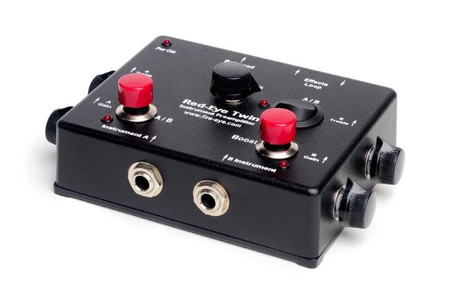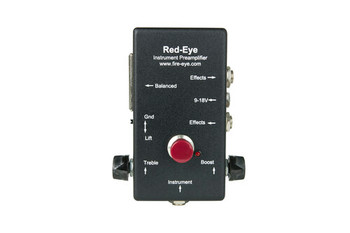Fire-Eye
Red-Eye Twin 2-channel Instrument Preamplifier
We ship worldwide! (Read this)
- FREE SHIPPING:
- to all 50 US States
Description
Note: All of our in-stock Red-Eye Twin preamps feature the newest revision, which is updated with the ground lift.
A longtime customer turned me on to these preamps from Fire-Eye, a custom manufacturer of musical gear based in Texas. I was instantly interested when I read about their design and build ethic on their website, and quickly got some in to check them out. I was not disappointed!
The Red-Eye preamps are all about getting pure sound with high-impedance piezoelectric pickups - as you likely know, that is the kind of pickup most commonly found on upright basses (as well as many electric uprights). Good to know for doublers, though: they can also be used for instruments with magnetic pickups such as electric guitars and electric basses.
 When they arrived, it was obvious that the guys at Fire-Eye put a strong emphasis on high-quality components, clean design, and impeccable construction. There are a few bells and whistles, but they forego some features for a straight up killer sound and avoid adding superfluous extras that just bring opportunities to pick up "junk" in the signal path.
When they arrived, it was obvious that the guys at Fire-Eye put a strong emphasis on high-quality components, clean design, and impeccable construction. There are a few bells and whistles, but they forego some features for a straight up killer sound and avoid adding superfluous extras that just bring opportunities to pick up "junk" in the signal path.
A couple important things to note about the Fire-Eye preamp, which set it apart from other common preamps:
- EQ controls are limited. The only EQ on this preamp is a treble control; it is useful for removing the clack, but it is set high in the frequency range. But the buffering is so well done, you should hardly need much EQ, if any, to get a great sound.
- There is not a labeled 1/4" output. However, the "Effects Loop Out" doubles as a 1/4" output, so if you're using it with your onstage amp, you can send the 1/4" to your regular instrument input. However, if you send your signal to a mixing board or an amp equipped with a "microphone" input on an XLR, the DI out is the preferred output - it is much better for reducing noise over long cable runs, so if you're a long way from your amp, you can feel confident that you won't be getting a lot of ugly interference.
How does it sound? Here's the tech-speak from Fire-Eye: The Red-Eye Preamp’s impedance-matching field-effect transistor input circuit is designed especially to match and track the impedance of passive piezoelectric pickups. That results in a smooth, natural, balanced, acoustic instrument tone. Low distortion, low noise, and generous headroom mean that clear tone comes through even when an instrument is played percussively and loudly.
They use some big words, there, but in my testing here at the shop, I've gotta say the thing made our Realist-equipped double bass, as well as an NS Design WAV4 electric upright, sound great with no knob-tweaking at all. And if you are someone who likes to twiddle knobs and dial in a tone, the preamp is equipped with an effects loop; you can use outboard effects (pedals, modules) to create exactly the timbre you're after.
Despite its fairly simple signal path, the Twin has some "under-the-hood" features that are particularly useful for bassists like me and you.
- It can be a blender: two channels, which can be mixed, make it easy to mix together two pickups at the same time.
- The input on Channel B can be switched to a microphone input, with electret phantom power - so it can be used with the K&K Golden Bullet, or similar small mics!
- It can be a switcher: perfect for doublers; put your upright bass in one channel and your electric (or electric upright) into the other, and switch back and forth to your heart's content.
- The boost feature is handy: use it to switch volumes for arco/pizzicato passages (arco through a pickup is always louder - a quick kickdown on the boost button will apply a correction for that.) Or use the boost for when you take a solo.
TL;DR: The Red-Eye Twin Instrument Preamp offers a simple, one-box, direct-connect solution for musicians that play two instruments at the same gig or have an instrument with dual pickups. The Red-Eye Twin works well with instruments having passive or active piezo pickups, as well as low-voltage electret microphones, or magnetic pickups, including electric guitars and basses. The straight dope is that this is a purpose-built high-impedance buffering preamp, with an emphasis on clean, uncolored sound. Tonal purists will totally dig this thing.
Features:
- Input: Impedance-matching, accepts 2 volt peak-to-peak level without distortion.
- Low-impedance, balanced, XLR output, 600 ohms, will drive long cables to mix-board.
- XLR Ground Lift Switch to help isolate AC power ground loop hum.
- A / B Button selects alternate input. Mode Switch allows playing alternate inputs or both.
- Separate Treble and Gain controls for each input. Treble is flat when Control is centered.
- Boost Button with Boost Gain control for amplifying solos.
- Switch converts B-Channel Input to Phantom Powered electret microphone input.
- Runs on 48V XLR Phantom Power, 9-18V Pedal Board Power, or 9V Battery Power.
- Uses the battery only if other power sources are not available.
- Plugging an instrument in or connecting external power turns the Red-Eye on.
- Pwr Chk Light illuminates for about a second if power is good when the preamp is powered up. When powered up on the battery, the light appears if the battery is in the first ¾ of its life.
- ¼ inch output and input for accessory loop, suitable for stomp-tuners or effects pedals or for output to on-stage guitar amps or PAs.
- Internal filtering to reject radio-frequency interference from neon lights and cell phones.
- Small Chassis Size: 1.25 x 3.5 x 4.5 inches. Weight: 18 ounces.
The preamp can be powered by an internal 9v battery (included), an external power supply (9v-18v, optional), or by phantom power supplied through the XLR output.
Product Manual
Need to figure out some of the more in-depth features of this product? Here's a copy of the manual, in PDF format, here.
You may wish to visit the manufacturer's website to see if a more recent version is available.





















